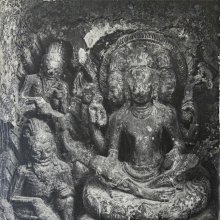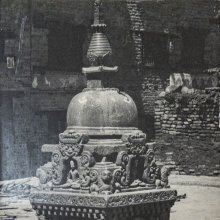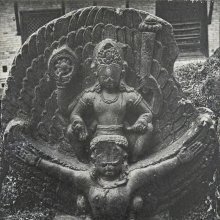Prastara, Prastāra: 26 definitions
Introduction:
Prastara means something in Hinduism, Sanskrit, Jainism, Prakrit, Marathi, Hindi. If you want to know the exact meaning, history, etymology or English translation of this term then check out the descriptions on this page. Add your comment or reference to a book if you want to contribute to this summary article.
Images (photo gallery)
In Hinduism
Vastushastra (architecture)
Source: Wisdom Library: Vāstu-śāstra1) Prastara (प्रस्तर) refers to the “entablature” of a temple (prāsāda or vimāna). It is considered the third part in the ṣaḍvarga structure.
2) Prastara (प्रस्तर):—One of the eight types of villages, according to Chapter 9 of the Mānasāra (called the grāmalakṣaṇam). The Mānasāra is one of the traditional authorative Hindu treatises on Vāstuśāstra. The form of this village is said to be tattadrūpeṇa, which means it represents the form of the meaning of its Sanskrit name.
Source: Shodhganga: Temples of Salem region Up to 1336 ADPrastara (प्रस्तर) means entablature. It is found above the architrave of the temple, inside or outside. Prastara is one of the six important architectural parts of the body of the temple. It is the third member of the temple building from the bottom. Prastara is considered very important in the architectural composition of the temple.
Prastara, in dravidian context, means a meeting place. This is the meeting place of the two divisions of the temple namely the prāsāda-varga and the pāda-varga. Pāda-varga represents the earth and prāsāda-varga represents the Heaven. In the entablature both pāda-varga and prāsāda-varga unite. Therefore this part is given the name prastara. According to Hindu metaphysics the mother Earth (bhūmi-tattva) is feminine (prakṛti) in character. It is embraced by ākāśa-tatva, which is masculine (puruṣa). The prastara represents the union of these two concepts.
Prastara, according to Mayamata, should be decorated with sculptures of yakṣas, vidyādharas, bhūtamāla, gaṇas, haṃsas, floral decorations, etc. According to Mānasāra the semi divine and demi-devine and other celestial beings are to be carved in śayana (lying) or āsīna (seated) postures.
Source: OpenEdition books: Architectural terms contained in Ajitāgama and RauravāgamaPrastara (प्रस्तर) refers to “- 1. entablature §§ 3.1, 23-24, 37; 4.6, 18, 36; 5.2. - 2. ceiling (located at the level of the entablature) (Aj) § 3.24. - 3.uperior strip (molding) (Aj) §§ 3.6, 23.”.—(For paragraphs cf. Les enseignements architecturaux de l'Ajitāgama et du Rauravāgama by Bruno Dagens)

Vastushastra (वास्तुशास्त्र, vāstuśāstra) refers to the ancient Indian science (shastra) of architecture (vastu), dealing with topics such architecture, sculpture, town-building, fort building and various other constructions. Vastu also deals with the philosophy of the architectural relation with the cosmic universe.
Shilpashastra (iconography)
Source: Wisdom Library: Śilpa-śāstraPrastara (प्रस्तर) refers to a “surface” (a flat top). It represents a part of the trivarga structure, where it is also known as kapota or paṭṭikā.

Shilpashastra (शिल्पशास्त्र, śilpaśāstra) represents the ancient Indian science (shastra) of creative arts (shilpa) such as sculpture, iconography and painting. Closely related to Vastushastra (architecture), they often share the same literature.
Chandas (prosody, study of Sanskrit metres)
Source: Shodhganga: a concise history of Sanskrit Chanda literature1) Prastāra (प्रस्तार, “permutations”).—The word prastāra is a technical term used in Sanskrit Prosody by which different kinds of calculations of metres are possible. Prosodists generally accept that the classical metres are the prastāras (permutations) of various Vedic metres like Gāyatrī, Uṣṇik, Bṛhatī and Triṣṭubh etc. Each metre is having a number of prastāras among which only very few are accepted and used by poets generally.
2) Prastāra (प्रस्तार) refers to one of the six pratyayas mentioned in the Chandomañjarī 1.14.—The pratyayas are the cause of expansion of metres (chandas). Generally six pratyayas are found in Sanskrit prosody (e.g., Prastāra). But Mitrānanda advocates about nine types of pratyayas.
3) Prastāra (प्रस्तार) is the name of a work ascribed to Rāmasvāmi Dīkṣita (father of Śivasūrya) related to the topics of Sanskrit prosody (chandas) but having an unknown period of composition.

Chandas (छन्दस्) refers to Sanskrit prosody and represents one of the six Vedangas (auxiliary disciplines belonging to the study of the Vedas). The science of prosody (chandas-shastra) focusses on the study of the poetic meters such as the commonly known twenty-six metres mentioned by Pingalas.
Natyashastra (theatrics and dramaturgy)
Source: Wisdom Library: Nāṭya-śāstraPrastāra (प्रस्तार) refers to one of the five limbs (aṅga) belonging to Aḍḍitā type of song (dhruvā) defined in the Nāṭyaśāstra chapter 32.9-16. Accordingly, “depending on different conditions, the dhruvās are known to be of five classes”.
Prastāra (प्रवृत्त) also refers to one of the two limbs (aṅga) belonging to Antarā type of song (dhruvā).

Natyashastra (नाट्यशास्त्र, nāṭyaśāstra) refers to both the ancient Indian tradition (shastra) of performing arts, (natya—theatrics, drama, dance, music), as well as the name of a Sanskrit work dealing with these subjects. It also teaches the rules for composing Dramatic plays (nataka), construction and performance of Theater, and Poetic works (kavya).
Shaivism (Shaiva philosophy)
Source: Shodhganga: Iconographical representations of ŚivaPrastāra (प्रस्तार) or Prastārāgama refers to one of upāgamas (supplementary scriptures) of the Vīrāgama which is one of the twenty-eight Siddhāntāgama: a classification of the Śaiva division of Śaivāgamas. The Śaivāgamas represent the wisdom that has come down from lord Śiva, received by Pārvatī and accepted by Viṣṇu. The purpose of revealing upāgamas (e.g., Prastāra Āgama) is to explain more elaborately than that of mūlāgamas (e.g., Vīra-āgama) and to include any new idea if not dealt in mūlāgamas.
Source: Brill: Śaivism and the Tantric TraditionsPrastara (प्रस्तर) refers to a “spread (of kuśa-grass)”, according to the Mataṅgapārameśvara (with Rāmakaṇṭha’s commentary).—Accordingly, “[...] [Rāmakaṇṭha]:—Now if you ask what this vidyāvrata is which he must have observed, this is what the text teaches: The power of the vidyā that is mentioned here [in this compound vidyāvrata] is first to be recited for a year in a temple to Śiva, while exercising control of the senses, maintaining purity (śuciṣmat—śuciṣmatā), eating daily [only the sacrificial gruel known as] caru, sleeping on the ground in the room reserved for pūjā and fire[-sacrifice] on a spread of kuśa-grass (kuśaprastara-śāyin), with his mind engaged [in meditation], focussed. [Rāmakaṇṭha]:—It [viz. the power of the vidyā] is the vyomavyāpin.
Source: eScholarship: The descent of scripture: a history of the KamikagamaPrastara (प्रस्तर) refers to “temple entablatures”, according to the Kāmikāgama: an ancient Śaiva Āgama scripture in 12,000 Sanskrit verses dating to at least the 5th century and represented as an encyclopedic account of ritual instructions (kriyāpāda).—In modern print editions, the Kāmika-āgama is structured in two major parts. The Pūrvabhāga consists of 75 chapters (paṭalas) [...] Chapters 49 to 61 focus on temple architecture and construction. [...] Chapter 53 details the dimensions and design of temple pillars. Chapter 54 describes temple entablatures (prastara).

Shaiva (शैव, śaiva) or Shaivism (śaivism) represents a tradition of Hinduism worshiping Shiva as the supreme being. Closely related to Shaktism, Shaiva literature includes a range of scriptures, including Tantras, while the root of this tradition may be traced back to the ancient Vedas.
Ayurveda (science of life)
Nighantu (Synonyms and Characteristics of Drugs and technical terms)
Source: Wisdom Library: Raj NighantuPrastara (प्रस्तर) refers to “stones” according to the second chapter (dharaṇyādi-varga) of the 13th-century Raj Nighantu or Rājanighaṇṭu (an Ayurvedic encyclopedia). The Dharaṇyādi-varga covers the lands, soil, mountains [viz., Prastara], jungles and vegetation’s relations between trees and plants and substances, with their various kinds.

Āyurveda (आयुर्वेद, ayurveda) is a branch of Indian science dealing with medicine, herbalism, taxology, anatomy, surgery, alchemy and related topics. Traditional practice of Āyurveda in ancient India dates back to at least the first millenium BC. Literature is commonly written in Sanskrit using various poetic metres.
Shaktism (Shakta philosophy)
Source: Google Books: ManthanabhairavatantramPrastāra (प्रस्तार) (or Gahvara) refers to a “grid” (or “diagram”) from which letters are extracted to make mantras. Such grids were well-known to earlier Tantric schools. This one in particular was drawn wholesale from the Trika school which, as we shall see, was the source of virtually all the major features of this Triangle (but not the Point in the centre of it) except those most specifically related to the Kubjikā cult. We may begin to briefly trace these developments from this feature of the Triangle.

Shakta (शाक्त, śākta) or Shaktism (śāktism) represents a tradition of Hinduism where the Goddess (Devi) is revered and worshipped. Shakta literature includes a range of scriptures, including various Agamas and Tantras, although its roots may be traced back to the Vedas.
In Jainism
General definition (in Jainism)
Source: archive.org: Een Kritische Studie Van Svayambhūdeva’s PaümacariuPrastāra (प्रस्तार) participated in the war between Rāma and Rāvaṇa, on the side of the latter, as mentioned in Svayambhūdeva’s Paumacariu (Padmacarita, Paumacariya or Rāmāyaṇapurāṇa) chapter 57ff. Svayambhū or Svayambhūdeva (8th or 9th century) was a Jain householder who probably lived in Karnataka. His work recounts the popular Rāma story as known from the older work Rāmāyaṇa (written by Vālmīki). Various chapters [mentioning Prastāra] are dedicated to the humongous battle whose armies (known as akṣauhiṇīs) consisted of millions of soldiers, horses and elephants, etc.
Source: academia.edu: Rare Sanskrit Words from the Commentary on the Bṛhat-kalpa-bhāṣyaPrastāra (प्रस्तार) refers to a “massacre” or “genocide”.—In his publication for the Journal of Jaina Studies, Yutaka Kawasaki collected in a non-definite list several rare Sanskrit words (e.g., prastāra) from Malayagiri’s and Kṣemakīrti’s commentaries on the Bṛhatkalpabhāṣya: a 6th century commentary on monastic discipline authored by Svetambara Jain exegete Saṅghadāsa.

Jainism is an Indian religion of Dharma whose doctrine revolves around harmlessness (ahimsa) towards every living being. The two major branches (Digambara and Svetambara) of Jainism stimulate self-control (or, shramana, ‘self-reliance’) and spiritual development through a path of peace for the soul to progess to the ultimate goal.
Languages of India and abroad
Marathi-English dictionary
Source: DDSA: The Molesworth Marathi and English Dictionaryprastāra (प्रस्तार).—m (S Commonly prasāra) Spreading or spread state. 2 In arithmetic. Combination.
Marathi is an Indo-European language having over 70 million native speakers people in (predominantly) Maharashtra India. Marathi, like many other Indo-Aryan languages, evolved from early forms of Prakrit, which itself is a subset of Sanskrit, one of the most ancient languages of the world.
Sanskrit dictionary
Source: DDSA: The practical Sanskrit-English dictionaryPrastara (प्रस्तर).—
1) A couch of leaves and flowers.
2) A couch or bed in general; इष्टकाप्रस्तरे चैव कण्टकप्रस्तरे तथा (iṣṭakāprastare caiva kaṇṭakaprastare tathā) (śayanam) Mahābhārata (Bombay) 12.33.1.
3) A flat surface or top, level, plain.
4) A stone, rock; पर्वतप्रतिमं भाति पर्वतप्रस्तराश्रितम् (parvatapratimaṃ bhāti parvataprastarāśritam) Mahābhārata (Bombay) 3.142.16.
5) A precious stone, gem.
6) A paragraph, section of a work.
7) A handful of darbha grass.
Derivable forms: prastaraḥ (प्रस्तरः).
--- OR ---
Prastāra (प्रस्तार).—
1) Strewing, spreading out, covering with.
2) A bed of leaves and flowers.
3) A bed or couch in general.
4) A flat surface, level, plain.
5) A thicket, wood.
6) (In prosody) A tabular representation of the long and short vowels of a metre with all possible varieties.
7) A process in preparing minerals.
8) A flight of steps (leading down to water; Mar. ghāṭa); मणिप्रवालप्रस्तारम् (maṇipravālaprastāram) Mahābhārata (Bombay) 3.145.5.
Derivable forms: prastāraḥ (प्रस्तारः).
Source: Cologne Digital Sanskrit Dictionaries: Shabda-Sagara Sanskrit-English DictionaryPrastara (प्रस्तर).—m.
(-raḥ) 1. A stone or rock. 2. A jewel, a precious stone. 3. A couch, made of flowers or grass. 4. Any bed or couch. 5. A flat, a level, a surface. 6. A tabular form of representing the long and short vowels of poetical metre. 7. Notation of music. 8. A handful or bundle of Kusa grass used at sacrifices. E. pra before, stṛ to spread, aff. ac .
--- OR ---
Prastāra (प्रस्तार).—m.
(-raḥ) 1. A jungle, a thicket or wood, overgrown with grass. 2. Covering, spreading. 3. A bed made with blossoms, leaves, &c. 4. Any bed or couch. 5. A flat surface, a plain. 6. Representation of the long and short vowels of a metre and its possible varieties, (in prosody.) E. pra before, stṛ to spread, aff. ghañ .
Source: Cologne Digital Sanskrit Dictionaries: Benfey Sanskrit-English DictionaryPrastara (प्रस्तर).—i. e. pra-stṛ10 + a, m. 1. A handful or bundle of Kuśa grass used at sacrifices. 2. A plain, level, [Rāmāyaṇa] 3, 79, 5; [Mānavadharmaśāstra] 2, 204. 3. A stone or rock, [Uttara Rāmacarita, 2. ed. Calc., 1862.] 71, 2.
--- OR ---
Prastāra (प्रस्तार).—i. e. pra-stṛ10 + a, m. 1. A bed. 2. A thicket or wood, overgrown with grass.
Source: Cologne Digital Sanskrit Dictionaries: Cappeller Sanskrit-English DictionaryPrastara (प्रस्तर).—[masculine] stramentum, layer, straw; bunch of grass ([ritual or religion]); surface, plain; stone, rock.
--- OR ---
Prastāra (प्रस्तार).—[masculine] spreading, extension, high degree; straw, cushion, bed, layer, plain, surface.
Source: Cologne Digital Sanskrit Dictionaries: Monier-Williams Sanskrit-English Dictionary1) Prastara (प्रस्तर):—[=pra-stara] a etc. See pra- √stṛ.
2) [=pra-stara] [from pra-stṛ] b m. (ifc. f(ā). ) anything strewed forth or about, a couch of leaves and flowers, ([especially]) a sacrificial seat, [Ṛg-veda] etc. etc.
3) [v.s. ...] (ifc.) a couch of any material, [Mahābhārata]
4) [v.s. ...] a flat surface, flat top, level, a plain, [Manu-smṛti; Mahābhārata; Rāmāyaṇa]
5) [v.s. ...] a rock, stone, [Kāvya literature; Hitopadeśa]
6) [v.s. ...] a gem, jewel, [cf. Lexicographers, esp. such as amarasiṃha, halāyudha, hemacandra, etc.]
7) [v.s. ...] a leather bag, [Mṛcchakaṭikā [Scholiast or Commentator]]
8) [v.s. ...] a paragraph, section, [Catalogue(s)]
9) [v.s. ...] a tabular representation of the long and short vowels of a metre, [Horace H. Wilson]
10) [v.s. ...] musical notation, [ib.]
11) [v.s. ...] [plural] Name of a people, [Rāmāyaṇa] ([varia lectio] for pra-cara)
12) Prastāra (प्रस्तार):—[=pra-stāra] [from pra-stṛ] m. (ifc. f(ā). ) strewing, spreading out, extension (also [figuratively] = abundance, high degree), [Mahābhārata; Kāvya literature]
13) [v.s. ...] a litter, bed of straw, [Harivaṃśa]
14) [v.s. ...] a layer, [Śulba-sūtra]
15) [v.s. ...] a flight of steps (leading down to water), [Mahābhārata]
16) [v.s. ...] a flat surface, plain, [Harivaṃśa] ([varia lectio] stara)
17) [v.s. ...] a jungle or wood overgrown with grass, [cf. Lexicographers, esp. such as amarasiṃha, halāyudha, hemacandra, etc.]
18) [v.s. ...] a process in preparing minerals, [Catalogue(s)]
19) [v.s. ...] a representation or enumeration of all the possible combinations of certain given numbers or of short and long syllables in a metre, [Colebrooke]
20) [v.s. ...] (in music) a kind of measure, [Saṃgīta-sārasaṃgraha]
21) [v.s. ...] Name of a prince (son of Udgītha), [Viṣṇu-purāṇa] ([probably] [wrong reading] for prastāva)
Source: Cologne Digital Sanskrit Dictionaries: Yates Sanskrit-English Dictionary1) Prastara (प्रस्तर):—[pra-stara] (raḥ) 1. m. A stone or rock; a jewel; a bed of flowers, notation of music; handful of grass.
2) Prastāra (प्रस्तार):—[pra-stāra] (raḥ) 1. m. A jungle or wood; bed of flowers; bed or couch.
Source: DDSA: Paia-sadda-mahannavo; a comprehensive Prakrit Hindi dictionary (S)Prastara (प्रस्तर) in the Sanskrit language is related to the Prakrit words: Patthaḍa, Patthara, Patthāra.
[Sanskrit to German]
Sanskrit, also spelled संस्कृतम् (saṃskṛtam), is an ancient language of India commonly seen as the grandmother of the Indo-European language family (even English!). Closely allied with Prakrit and Pali, Sanskrit is more exhaustive in both grammar and terms and has the most extensive collection of literature in the world, greatly surpassing its sister-languages Greek and Latin.
Hindi dictionary
Source: DDSA: A practical Hindi-English dictionaryPrastara (प्रस्तर) [Also spelled prastar]:—(nm) stone; rock; entablature; -[pratimā] a stone-statue; -[yuga] stone age.
...
Kannada-English dictionary
Source: Alar: Kannada-English corpusPrastara (ಪ್ರಸ್ತರ):—
1) [noun] a bed made by spreading plant leaves and flowers.
2) [noun] a bed or couch.
3) [noun] a piece of land that is uniformly level.
4) [noun] a piece of stone.
--- OR ---
Prastāra (ಪ್ರಸ್ತಾರ):—
1) [noun] the act of spreading over or covering a wide area with (something).
2) [noun] the act or fact of being spread so.
3) [noun] the mattress used to sleep on; a bed.
4) [noun] a dense forest.
5) [noun] the act or process of finding the prosody of a verse.
6) [noun] a singing or playing of the musical notes in different combinations rhythmically, in different speeds, which enhances the beauty of the musical mode and creates excitement in the audience.
7) [noun] arecognising of musical note of a song sung and writing it as per the rules of notation.
Kannada is a Dravidian language (as opposed to the Indo-European language family) mainly spoken in the southwestern region of India.
See also (Relevant definitions)
Starts with (+3): Prastarabhajana, Prastaracakra, Prastarachakra, Prastarachintamani, Prastaracintamani, Prastaracintamanitantra, Prastaradyashtakarmavyakhya, Prastaraghatanopakarana, Prastaraka, Prastaramurti, Prastarana, Prastaranayana, Prastaranirupana, Prastarapankti, Prastarapattana, Prastarapraharananyaya, Prastarashayin, Prastarashekhara, Prastarasindhu, Prastarasveda.
Ends with (+6): Adhahprastara, Adibharataprastara, Agniprastara, Ardhaprastara, Bhuprastara, Chandahprastara, Chhandahprastara, Hridayaprastara, Khandaprastara, Kushaprastara, Mantraprastara, Matraprastara, Meruprastara, Nilaprastara, Prasadaprastara, Pratiprastara, Pushpaprastara, Ragaprastara, Samprastara, Saprastara.
Full-text (+86): Agniprastara, Patthara, Adhahprastara, Patthada, Yathaprastaram, Prastaracintamani, Prastarapattana, Prastarana, Hridayaprastara, Prastarapankti, Prastarabhajana, Prasadaprastara, Prastaraghatanopakarana, Prastarasveda, Prastarasvedana, Pirastaram, Prastarini, Prastarin, Pirattari, Saprastara.
Relevant text
Search found 37 books and stories containing Prastara, Prastāra, Pra-stara, Pra-stāra; (plurals include: Prastaras, Prastāras, staras, stāras). You can also click to the full overview containing English textual excerpts. Below are direct links for the most relevant articles:
Kashyapa Shilpa-shastra (study) (by K. Vidyuta)
8. Śālā, Sabhā and Mālikā-kāra Lakṣaṇas < [Chapter 5 - Gopura Lakṣaṇa]
4 (b). Technical terms for the component parts of the temple < [Chapter 2 - Author and his Works]
6. Components in the Storeys of the Gopuras < [Chapter 5 - Gopura Lakṣaṇa]
Rig Veda (translation and commentary) (by H. H. Wilson)
Rig Veda 10.14.4 < [Sukta 14]
Bhagavati-sutra (Viyaha-pannatti) (by K. C. Lalwani)
Vasudevavijaya of Vasudeva (Study) (by Sajitha. A)
Rāsakrīḍā of Rāmapāṇivāda < [Chapter 1 - Śāstrakāvyas—A Brief Survey]
Vastu-shastra (1): Canons of Architecture (by D. N. Shukla)
(v) The character of the building aspect etc. (Patākādi-ṣaṭ-chandas) < [Chapter 6 - Fundamental Canons of Hindu Architecture]
(v,1) Vāstu in Vedic literature < [Chapter 4 - An outline History of Hindu Architecture]
(iv) The Six Canons of Hindu Architecture (Āyādi-ṣaḍvarga) < [Chapter 6 - Fundamental Canons of Hindu Architecture]
The Agni Purana (by N. Gangadharan)
Related products




